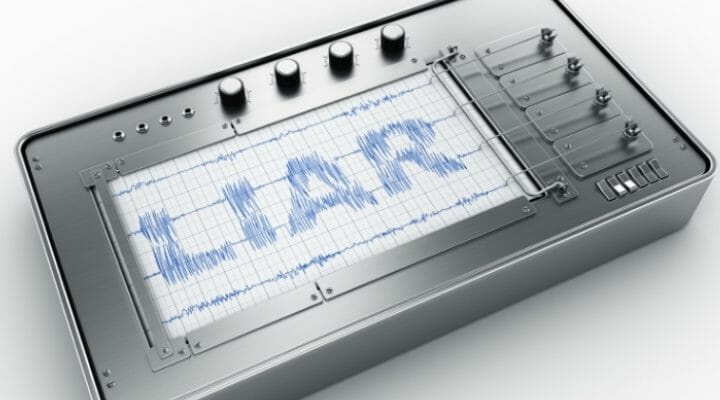Wonder Woman uses her lasso of truth to detect lies. That’s not surprising—William Moulton Marston, the man who invented the lie detector, created the Wonder Woman legend. The question since Marston’s lie detector came on the scene is, does it work? Can the lie detector really determine with confidence whether one is telling the truth, or lying? While courts say no, your new employer may say yes, and so many agencies these days rely on the Marston machine for the sake of security clearances. In fact, the Defense Intelligence Agency now requires a polygraph for contracted employees.
COURT SAYS NO
About this time of year back in 1923, the Supreme Court of the United States said no. Frye v. United States decided that the lie detector does not reach the high, strict standards of evidence required in a court of law: “the systolic blood pressure deception test has not yet gained such standing and scientific recognition among physiological and psychological authorities” that expert witnesses can draw conclusions from that evidence. “Courts of appeals have generally upheld this principle in the years since,” writes PriceOnEconomics contributor Simon Gardner, “which has made the use of polygraphs in formal legal contexts a rarity.” Then along came the functional magnetic resonance imaging, or fMRI.
DETECTING LIES
As Gardner explains, “The polygraph is based on the theory that the act of lying elicits an emotional response, and that measuring this response can distinguish lies from the truth.” The traditional polygraph records an emotional response by measuring changes in the systolic blood pressure and electrical activity in the skin. Whether those changes necessarily mean one is lying—or whether it just means one’s just reacting to the implications of being hooked to a truth machine—is a matter of long debate. However, the notion that emotions change physical responses, like the very physiological flight or fight response associated with fear and anxiety, is pretty well accepted. So, why not measure those sorts of changes more vividly?
fMRI AS POLYGRAPH
The fMRI produces actual images of changes in brain activity that correlate with emotional changes—or any other function or dysfunction that visibly affects blood flow in the brain and spinal cord. If you use a particular part of your brain, blood goes there. When that part of the brain is resting, the brain requires less blood. The fMRI provides a snapshot of that sort of change in your brain.
Health Imaging contributor Jodelle Maglaya reports, “In work published in the Journal of Clinical Psychiatry, researchers in the Perelman School of Medicine at the University of Pennsylvania found that when a lie is told, experts can see on fMRI scans that the area of the brain linked to decision making lights up.” According to Maglaya, “Studies showed the ability for fMRI to detect someone lying with up to 90 percent accuracy, where as a polygraph ranges from chance to 100 percent, varying from different studies.” Additionally, Neuroscience News reports that “neuroscience experts without prior experience in lie detection, using fMRI data, were 24 percent more likely to detect deception than professional polygraph examiners reviewing polygraph recordings.”
HOW THEY KNOW
The fMRI lie detection research conclusion rely on what’s known as Concealed Information or Guilty Knowledge Tests. Essentially, participants are provided a series of information and, then, over the course of questions while jammed inside the fMRI, participants lie on one of the responses, which is very much the way the traditional polygraph calibrates. Like polygraph operators, fMRI researches asked “carefully constructed questions, some of which have known answers . . . looking for responses that are accompanied by spikes in physiological activity,” explains Neuroscience News. Polygraph examiners go through this routine “to demonstrate the effectiveness of their methods to subjects prior to the actual polygraph examination.” That’s why the polygraph operator asks things like, “Is your name Edward C. Ledford?” and people named Edward C. Ledford like me respond, “Uhhhhhhhhhh, yes? Yes! Yes.”
NO NEW MARSTON MACHINE
Functional magnetic resonance imaging is not cheap, especially in comparison to the good old polygraph, so unless science develops an inexpensive, more mobile fMRI, I doubt we’ll see fMRIs replace Marston’s lasso of truth polygraph. Additionally, while the fMRI may seem more convincing as a matter of evidence—and it may detect with more precision the actual changes in the brain that produce the physical changes in heart rate and blood pressure—we’re left with the perhaps unsolvable question related to the reasons why some individual under certain circumstances has a particular emotional response to a particular question. Is it because he or she is telling the truth, or something else? That grey area fails to achieve the standards of evidence necessary for reasonable expert deductions.
The Journal’s report is available for online for $40.00 at Psychiatrist.Com. I’m crowd sourcing the funds to buy a copy.



